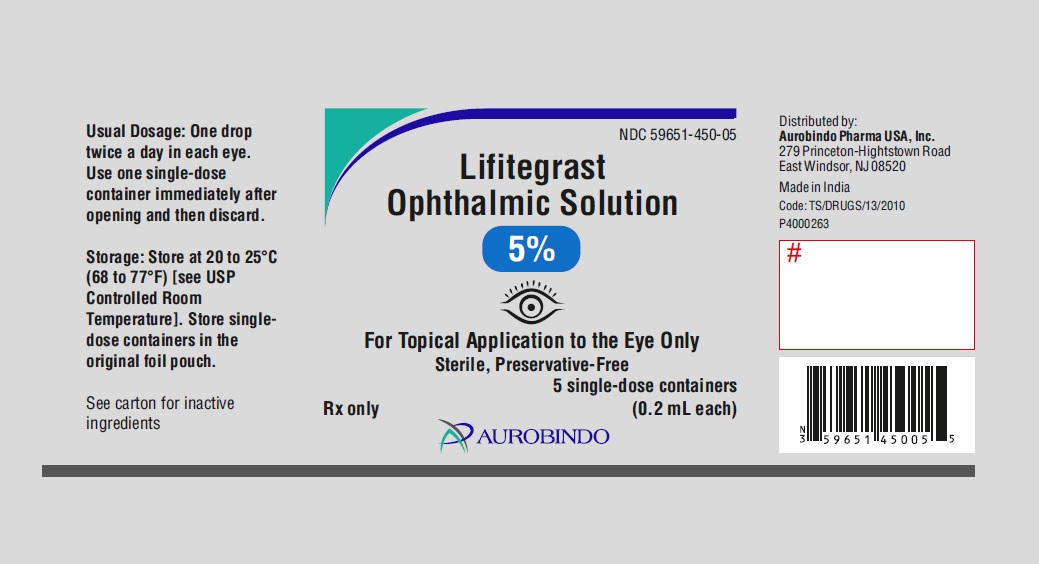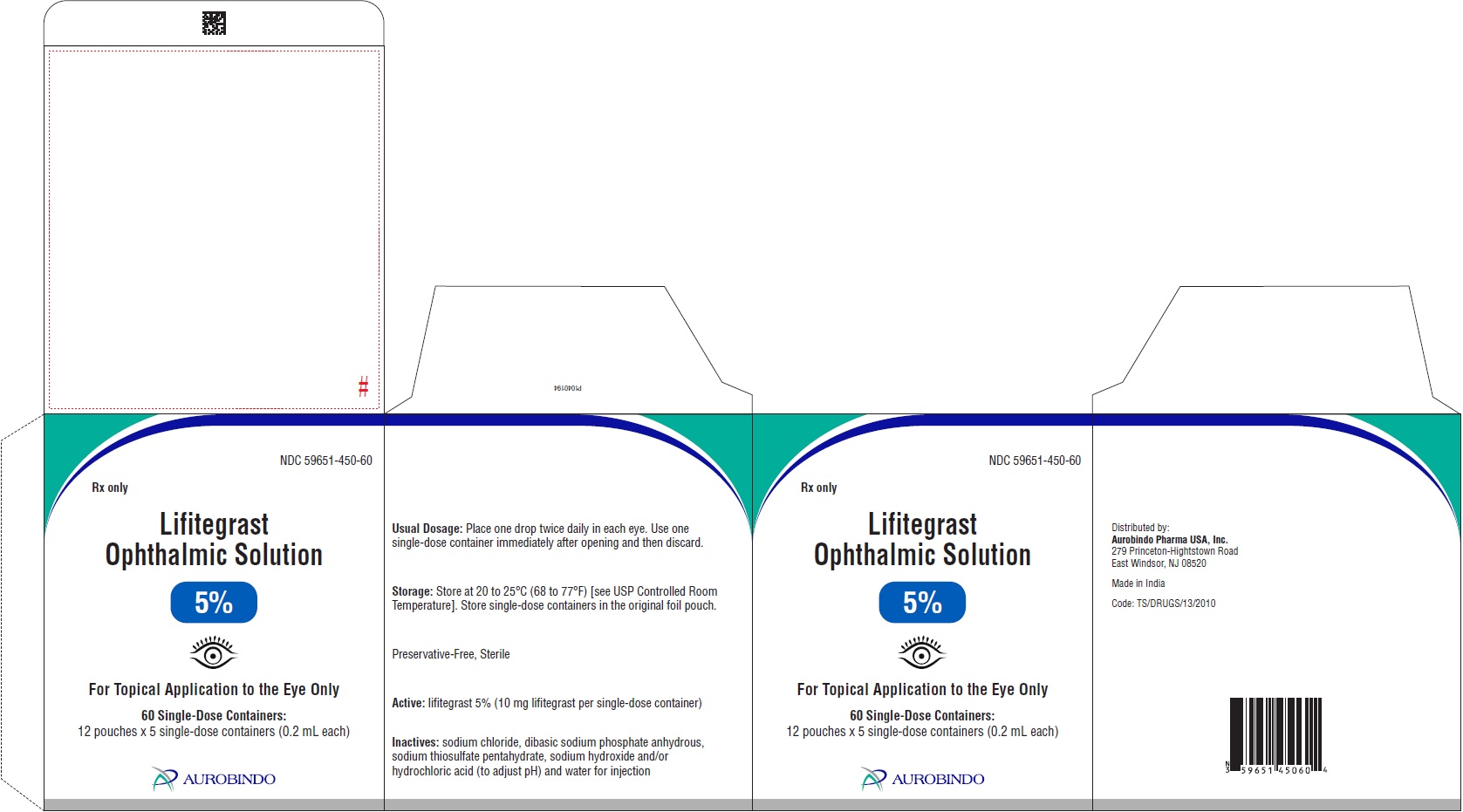Label: LIFITEGRAST for solution
- NDC Code(s): 59651-450-05, 59651-450-60
- Packager: Aurobindo Pharma Limited
- Category: HUMAN PRESCRIPTION DRUG LABEL
Drug Label Information
Updated November 13, 2023
If you are a healthcare professional or from the pharmaceutical industry please visit this version.
- Download DRUG LABEL INFO: PDF XML
- Official Label (Printer Friendly)
-
HIGHLIGHTS OF PRESCRIBING INFORMATION
These highlights do not include all the information needed to use LIFITEGRAST OPHTHALMIC SOLUTION safely and effectively. See full prescribing information for LIFITEGRAST OPHTHALMIC SOLUTION.
LIFITEGRAST ophthalmic solution, for topical ophthalmic use
Initial U.S. Approval: 2016INDICATIONS AND USAGE
Lifitegrast ophthalmic solution 5% is a lymphocyte function-associated antigen-1 (LFA-1) antagonist indicated for the treatment of the signs and symptoms of dry eye disease (DED). (1)
DOSAGE AND ADMINISTRATION
One drop twice daily in each eye (approximately 12 hours apart). (2)
DOSAGE FORMS AND STRENGTHS
Ophthalmic solution containing lifitegrast 50 mg/mL (5%). (3)
CONTRAINDICATIONS
Hypersensitivity. (4)
ADVERSE REACTIONS
The most common adverse reactions (incidence 5% to 25%) following the use of lifitegrast were instillation-site irritation, dysgeusia and decreased visual acuity. (6)
To report SUSPECTED ADVERSE REACTIONS, contact Aurobindo Pharma USA, Inc., at 1-866-850-2876 or FDA at 1-800-FDA-1088 or www.fda.gov./medwatch.
See 17 for PATIENT COUNSELING INFORMATION and FDA-approved patient labeling.
Revised: 9/2023
-
Table of Contents
FULL PRESCRIBING INFORMATION: CONTENTS*
1 INDICATIONS AND USAGE
2 DOSAGE AND ADMINISTRATION
3 DOSAGE FORMS AND STRENGTHS
4 CONTRAINDICATIONS
6 ADVERSE REACTIONS
6.1 Clinical Trials Experience
6.2 Postmarketing Experience
8 USE IN SPECIFIC POPULATIONS
8.1 Pregnancy
8.2 Lactation
8.4 Pediatric Use
8.5 Geriatric Use
11 DESCRIPTION
12 CLINICAL PHARMACOLOGY
12.1 Mechanism of Action
12.3 Pharmacokinetics
13 NONCLINICAL TOXICOLOGY
13.1 Carcinogenesis, Mutagenesis, Impairment of Fertility
14 CLINICAL STUDIES
16 HOW SUPPLIED/STORAGE AND HANDLING
17 PATIENT COUNSELING INFORMATION
- *
- Sections or subsections omitted from the full prescribing information are not listed.
- 1 INDICATIONS AND USAGE
-
2 DOSAGE AND ADMINISTRATION
Instill one drop of lifitegrast ophthalmic solution twice daily (approximately 12 hours apart) into each eye using a single-dose container. Discard the single-dose container immediately after using in each eye.
Contact lenses should be removed prior to the administration of lifitegrast ophthalmic solution and may be reinserted 15 minutes following administration. - 3 DOSAGE FORMS AND STRENGTHS
-
4 CONTRAINDICATIONS
Lifitegrast is contraindicated in patients with known hypersensitivity to lifitegrast or to any of the other ingredients in the formulation [see Adverse Reactions (6.2)].
-
6 ADVERSE REACTIONS
The following serious adverse reactions are described elsewhere in the labeling:
• Hypersensitivity [see Contraindications (4)]
6.1 Clinical Trials Experience
Because clinical trials are conducted under widely varying conditions, adverse reaction rates observed in clinical trials of a drug cannot be directly compared to rates in the clinical trials of another drug and may not reflect the rates observed in practice.
In five clinical trials of DED conducted with lifitegrast ophthalmic solution, 1401 patients received at least one dose of lifitegrast (1287 of which received lifitegrast 5%). The majority of patients (84%) had less than or equal to 3 months of treatment exposure. One hundred-seventy patients were exposed to lifitegrast for approximately 12 months. The majority of the treated patients were female (77%). The most common adverse reactions reported in 5% to 25% of patients were instillation-site irritation, dysgeusia, and reduced visual acuity.
Other adverse reactions reported in 1% to 5% of the patients were blurred vision, conjunctival hyperemia, eye irritation, headache, increased lacrimation, eye discharge, eye discomfort, eye pruritus, and sinusitis.
6.2 Postmarketing Experience
The following adverse reactions have been identified during post-approval use of lifitegrast. Because these reactions are reported voluntarily from a population of uncertain size, it is not always possible to reliably estimate their frequency or establish a causal relationship to drug exposure.
Rare serious cases of hypersensitivity, including anaphylactic reaction, bronchospasm, respiratory distress, pharyngeal edema, swollen tongue, urticaria, allergic conjunctivitis, dyspnea, angioedema, and allergic dermatitis have been reported. Eye swelling and rash have also been reported [see Contraindications (4)].
-
8 USE IN SPECIFIC POPULATIONS
8.1 Pregnancy
Risk Summary
There are no available data on lifitegrast use in pregnant women to inform any drug-associated risks. Intravenous (IV) administration of lifitegrast to pregnant rats, from premating through gestation day 17, did not produce teratogenicity at clinically relevant systemic exposures. Intravenous administration of lifitegrast to pregnant rabbits during organogenesis produced an increased incidence of omphalocele at the lowest dose tested, 3 mg/kg/day (400-fold the human plasma exposure at the recommended human ophthalmic dose [RHOD], based on the area under the curve [AUC] level). Since human systemic exposure to lifitegrast following ocular administration of lifitegrast at the RHOD is low, the applicability of animal findings to the risk of lifitegrast use in humans during pregnancy is unclear [see Clinical Pharmacology (12.3)].
Data
Animal Data
Lifitegrast administered daily by IV injection to rats, from premating through gestation day 17, caused an increase in mean pre-implantation loss and an increased incidence of several minor skeletal anomalies at 30 mg/kg/day, representing 5,400-fold the human plasma exposure at the RHOD of lifitegrast, based on AUC. No teratogenicity was observed in the rat at 10 mg/kg/day (460-fold the human plasma exposure at the RHOD, based on AUC). In the rabbit, an increased incidence of omphalocele was observed at the lowest dose tested, 3 mg/kg/day (400-fold the human plasma exposure at the RHOD, based on AUC), when administered by IV injection daily from gestation days 7 through 19. A fetal no observed adverse effect level (NOAEL) was not identified in the rabbit.
8.2 Lactation
Risk Summary
There are no data on the presence of lifitegrast in human milk, the effects on the breastfed infant, or the effects on milk production. However, systemic exposure to lifitegrast from ocular administration is low [see Clinical Pharmacology (12.3)]. The developmental and health benefits of breastfeeding should be considered, along with the mother’s clinical need for lifitegrast and any potential adverse effects on the breastfed child from lifitegrast.
-
11 DESCRIPTION
The chemical name for lifitegrast is (S)-2-(2-(benzofuran-6-carbonyl)-5,7-dichloro-1,2,3,4-tetrahydroisoquinoline-6-carboxamido)-3-(3-(methylsulfonyl)phenyl)propanoic acid. The molecular formula of lifitegrast is C29H24Cl2N2O7S and its molecular weight is 615.5 g/mol. The structural formula of lifitegrast is:
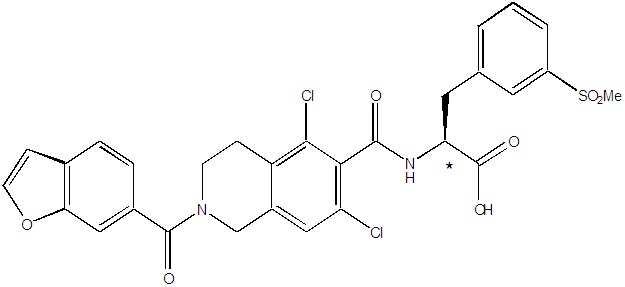
*Chiral center
Lifitegrast is a white to off-white powder, which is practically insoluble in water.
Lifitegrast ophthalmic solution 5% is a lymphocyte function-associated antigen-1 (LFA-1) antagonist supplied as a sterile, clear, colorless to slightly brownish-yellow colored, isotonic solution of lifitegrast with a pH of 7.0 to 8.0 and an osmolality range of 200 to 330 mOsmol/kg.
Lifitegrast ophthalmic solution contains Active: lifitegrast 50 mg/mL; Inactives: sodium chloride, dibasic sodium phosphate anhydrous, sodium thiosulfate pentahydrate, sodium hydroxide and/or hydrochloric acid (to adjust pH) and water for injection.
-
12 CLINICAL PHARMACOLOGY
12.1 Mechanism of Action
Lifitegrast binds to the integrin LFA-1, a cell surface protein found on leukocytes and blocks the interaction of LFA-1 with its cognate ligand intercellular adhesion molecule-1 (ICAM-1). ICAM-1 may be overexpressed in corneal and conjunctival tissues in DED. LFA-1/ICAM-1 interaction can contribute to the formation of an immunological synapse resulting in T-cell activation and migration to target tissues. In vitro studies demonstrated that lifitegrast may inhibit T-cell adhesion to ICAM-1 in a human T-cell line and may inhibit secretion of inflammatory cytokines in human peripheral blood mononuclear cells. The exact mechanism of action of lifitegrast in DED is not known.
12.3 Pharmacokinetics
In a subset of DED patients (n = 47) enrolled in a Phase 3 trial, the pre-dose (trough) plasma concentrations of lifitegrast were measured after 180 and 360 days of topical ocular dosing (one drop twice daily) with lifitegrast ophthalmic solution 5%. A total of nine of the 47 patients (19%) had plasma lifitegrast trough concentrations above 0.5 ng/mL (the lower limit of assay quantitation). Trough plasma concentrations that could be quantitated ranged from 0.55 ng/mL to 3.74 ng/mL.
-
13 NONCLINICAL TOXICOLOGY
13.1 Carcinogenesis, Mutagenesis, Impairment of Fertility
Carcinogenesis
Animal studies have not been conducted to determine the carcinogenic potential of lifitegrast.
Mutagenesis
Lifitegrast was not mutagenic in the in vitro Ames assay. Lifitegrast was not clastogenic in the in vivo mouse micronucleus assay. In an in vitro chromosomal aberration assay using mammalian cells (Chinese hamster ovary cells), lifitegrast was positive at the highest concentration tested, without metabolic activation.
Impairment of Fertility
Lifitegrast administered at IV doses of up to 30 mg/kg/day (5400-fold the human plasma exposure at the RHOD of lifitegrast ophthalmic solution, 5%) had no effect on fertility and reproductive performance in male and female-treated rats.
-
14 CLINICAL STUDIES
The safety and efficacy of lifitegrast for the treatment of DED were assessed in a total of 1181 patients (1067 of which received lifitegrast 5%) in four 12-week, randomized, multi-center, double-masked, vehicle-controlled studies. Patients were randomized to lifitegrast or vehicle (placebo) in a 1:1 ratio and dosed twice a day. Use of artificial tears was not allowed during the studies. The mean age was 59 years (range, 19 to 97 years). The majority of patients were female (76%). Enrollment criteria included minimal signs (i.e., Corneal Fluorescein Staining and non-anesthetized Schirmer Tear Test) and symptoms (i.e., Eye Dryness Score (EDS) and Ocular Discomfort Score) severity scores at baseline.
Effects on Symptoms of Dry Eye Disease
Eye dryness score was rated by patients using a visual analogue scale (0 = no discomfort, 100 = maximal discomfort) at each study visit. The average baseline EDS was between 40 and 70. A larger reduction in EDS favoring lifitegrast was observed in all studies at Day 42 and Day 84 (see Figure 1).
Figure 1: Mean Change (SD) from Baseline and Treatment Difference (Lifitegrast – Vehicle) in Eye Dryness Score in 12-Week Studies in Patients with Dry Eye Disease
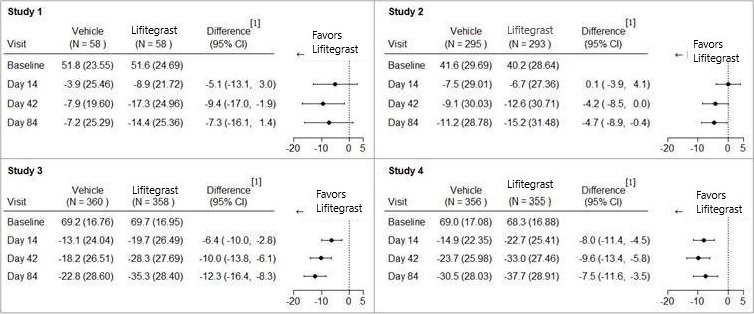
[1] Based on analysis of covariance (ANCOVA) model adjusted for baseline value in Study 1, and ANCOVA model adjusted for baseline value and randomization stratification factors in Studies 2 to 4. All randomized and treated patients were included in the analysis and missing data were imputed using last-available data. In Study 1, one lifitegrast-treated subject who did not have a baseline value was excluded from analysis.
Effects on Signs of Dry Eye Disease
Inferior fluorescein corneal staining score (ICSS) (0 = no staining, 1 = few/rare punctate lesions, 2 = discrete and countable lesions, 3 = lesions too numerous to count but not coalescent, 4 = coalescent) was recorded at each study visit. The average baseline ICSS was approximately 1.8 in Studies 1 and 2, and 2.4 in Studies 3 and 4. At Day 84, a larger reduction in ICSS favoring lifitegrast was observed in three of the four studies (see Figure 2).
Figure 2: Mean Change (SD) from Baseline and Treatment Difference (Lifitegrast – Vehicle) in Inferior Corneal Staining Score in 12-Week Studies in Patients with Dry Eye Disease
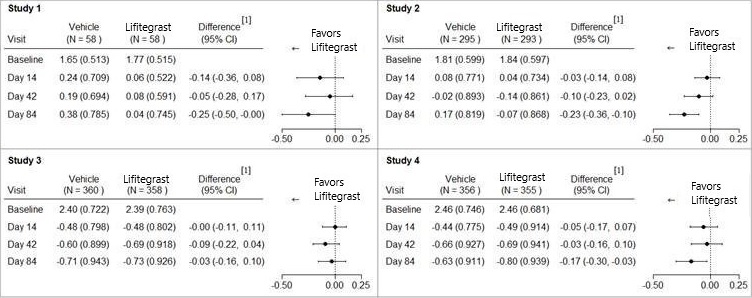
[1] Based on ANCOVA model adjusted for baseline value in Study 1, and ANCOVA model adjusted for baseline value and randomization stratification factors in Studies 2 to 4. All randomized and treated patients were included in the analysis and missing data were imputed using last-available data. In Study 2, one vehicle-treated subject who did not have a study eye designated was excluded from analysis.
-
16 HOW SUPPLIED/STORAGE AND HANDLING
Lifitegrast ophthalmic solution 5% (50 mg/mL) is a sterile, clear, colorless to slightly brownish-yellow colored solution and is supplied in a foil pouch containing 5 low-density polyethylene 0.2 mL single-dose containers.
5 x 0.2 mL single-dose containers
Packaged in a pouch NDC 59651-450-05
60 x 0.2 mL single-dose containers
Packaged in a carton (12 pouches x 5 single-dose containers) NDC 59651-450-60
Storage:
Store at 20 to 25°C (68 to 77°F) [see USP Controlled Room Temperature]. Store single-dose containers in the original foil pouch.
-
17 PATIENT COUNSELING INFORMATION
Advise patients to read the FDA-approved patient labeling (Patient Information and Instructions for Use).
Handling the Single-Dose Container
Advise patients not to touch the tip of the single-dose container to their eye or to any surface, in order to avoid eye injury or contamination of the solution.
Use with Contact Lenses
Advise patients that contact lenses should be removed prior to administration of lifitegrast ophthalmic solution and can be reinserted 15 minutes after administration [see Dosage and Administration (2)].
Administration
Advise patients that the solution from one single-dose container is to be used immediately after opening. It can be used to dose both eyes. The single-dose container, including any remaining contents should be discarded immediately after administration [see Dosage and Administration (2)].
Storage Information
Instruct patients to store single-dose containers in the original foil pouch until ready to use [see How Supplied/Storage and Handling (16)].
Dispense with Patient Information and Instructions for Use available at: https://www.aurobindousa.com/medication-guides/
Distributed by:
Aurobindo Pharma USA, Inc.
279 Princeton-Hightstown Road
East Windsor, NJ 08520
Manufactured by:
Eugia Pharma Specialities Limited
Hyderabad - 500032
India -
PATIENT INFORMATION
Lifitegrast (lif i TEG rast) Ophthalmic Solution 5%
for topical ophthalmic useWhat is lifitegrast ophthalmic solution?
Lifitegrast ophthalmic solution is a prescription eye drop solution used to treat the signs and symptoms of dry eye disease (DED). It is not known if lifitegrast ophthalmic solution is safe and effective in children under 17 years of age.
Do not use lifitegrast ophthalmic solution:- If you are allergic to lifitegrast or any of the other ingredients in lifitegrast ophthalmic solution, see "What are the ingredients in lifitegrast ophthalmic solution?"
Before you use lifitegrast ophthalmic solution, tell your doctor if you:
- are using any other eye drops
- wear contact lenses
- are pregnant or plan to become pregnant. It is not known if lifitegrast ophthalmic solution will harm your unborn baby.
- are breastfeeding or plan to breastfeed. It is not known if lifitegrast ophthalmic solution passes into your breast milk. Talk to your doctor about the best way to feed your baby if you use lifitegrast ophthalmic solution.
How should I use lifitegrast ophthalmic solution?
See the complete Instructions for Use at the end of this Patient Information leaflet for detailed instructions about the right way to use lifitegrast ophthalmic solution.- Use lifitegrast ophthalmic solution as your doctor tells you.
- Use one drop of lifitegrast ophthalmic solution in each eye, two times each day, about 12 hours apart.
- Use lifitegrast ophthalmic solution right away after opening. Throw away the single-dose container and any unused solution after you have applied the dose to both eyes. Do not save any unused lifitegrast ophthalmic solution for later.
What are the possible side effects of lifitegrast ophthalmic solution?
The most common side effects of lifitegrast ophthalmic solution include eye irritation, discomfort, or blurred vision when the drops are applied to the eyes, and an unusual taste sensation (dysgeusia).
Seek medical care immediately if you get any symptoms of wheezing, difficulty breathing, or swollen tongue.
These are not all the possible side effects of lifitegrast ophthalmic solution.
Tell your doctor if you have any side effects that bother you. You may report side effects to FDA at 1-800-FDA-1088.
How should I store lifitegrast ophthalmic solution?- Store lifitegrast ophthalmic solution at room temperature between 20°C to 25°C (68°F to 77°F).
- Store lifitegrast ophthalmic solution in the original foil pouch to protect it from light.
- Do not open the lifitegrast ophthalmic solution foil pouch until you are ready to use the eye drops.
- Return unused single-dose containers to their original foil pouch to protect from excessive light exposure.
Keep lifitegrast ophthalmic solution and all medicines out of the reach of children.
General information about the safe and effective use of lifitegrast ophthalmic solution.
Medicines are sometimes prescribed for purposes other than those listed in a Patient Information leaflet. You can ask your pharmacist or doctor for information about lifitegrast ophthalmic solution that is written for health professionals. Do not use lifitegrast ophthalmic solution for a condition for which it was not prescribed. Do not give lifitegrast ophthalmic solution to other people, even if they have the same symptoms you have. It may harm them.
What are the ingredients in lifitegrast ophthalmic solution?
Active ingredient: lifitegrast
Inactive ingredients: sodium chloride, dibasic sodium phosphate anhydrous, sodium thiosulfate pentahydrate, sodium hydroxide and/or hydrochloric acid (to adjust pH) and water for injection.
For more information, go to www.aurobindousa.com or call 1-866-850-2876.
This Patient Information has been approved by the U.S. Food and Drug Administration.
Dispense with Patient Information and Instructions for Use available at: https://www.aurobindousa.com/medication-guides/
Distributed by:
Aurobindo Pharma USA, Inc.
279 Princeton-Hightstown Road
East Windsor, NJ 08520
Manufactured by:
Eugia Pharma Specialities Limited
Hyderabad - 500032
India
Revised: September 2023
-
INSTRUCTIONS FOR USE
Lifitegrast [lif i TEG rast] Ophthalmic Solution 5%
for topical ophthalmic use
Read this Instructions for Use before you start using lifitegrast ophthalmic solution and each time you get a refill. There may be new information. This leaflet does not take the place of talking to your doctor about your medical condition or your treatment.
Important Information You Need to Know Before Using Lifitegrast Ophthalmic Solution:- Lifitegrast ophthalmic solution is for use in the eye.
- Wash your hands before each use to make sure you do not infect your eyes while using lifitegrast ophthalmic solution.
- If you wear contact lenses, remove them before using lifitegrast ophthalmic solution.
- Lifitegrast ophthalmic solution single-dose containers are packaged in a foil pouch. Do not remove from the foil pouch until you are ready to use lifitegrast ophthalmic solution.
- Do not let the tip of the lifitegrast ophthalmic solution single-dose container touch your eye or any other surfaces.
- Use one drop of lifitegrast ophthalmic solution in each eye two times each day (one drop in the morning and one drop in the evening, approximately 12 hours apart). Each single-dose container of lifitegrast ophthalmic solution will give you enough medicine to treat both of your eyes, one time. There is some extra lifitegrast ophthalmic solution in each single-dose container in case you miss getting a drop into your eye. After you have applied the drops, throw away the single-dose container and any unused lifitegrast ophthalmic solution. Do not save any unused lifitegrast ophthalmic solution.
Follow Steps 1 to 9 each time you use lifitegrast ophthalmic solution.
Step 1. Take a foil pouch out of the lifitegrast ophthalmic solution box. Open the pouch and remove the strip of single-dose containers (see Figure A).
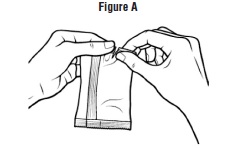
Pull off one single-dose container from the strip (see Figure B).
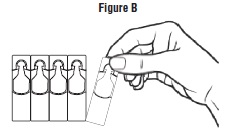
Step 2. Put the remaining strip of single-dose containers back in the pouch (see Figure C).
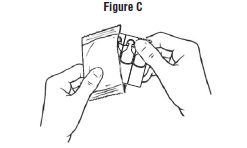
Fold the edge to close the pouch (see Figure D).
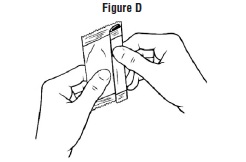
Step 3. Hold the lifitegrast ophthalmic solution container upright (see Figure E).
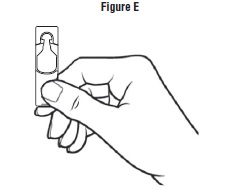
Tap the top of the container until all of the solution is in the bottom part of the container (see Figure F).
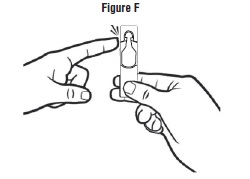
Step 4. Open the lifitegrast ophthalmic solution single-dose container by twisting off the tab. Make sure that the tip of the single-dose container does not touch anything, to avoid contamination (see Figure G).

Step 5. Tilt your head backwards. If you are not able to tilt your head, lie down.
Step 6. Gently pull your lower eyelid downwards and look up.
Step 7. Place the tip of the lifitegrast ophthalmic solution single-dose container close to your eye, but be careful not to touch your eye with it.
Step 8. Gently squeeze the single-dose container and let one drop of lifitegrast ophthalmic solution fall into the space between your lower eyelid and your eye. If a drop misses your eye, try again (see Figure H).

Step 9. Repeat Steps 5 to 8 for your other eye. There is enough lifitegrast ophthalmic solution in one single-dose container for both eyes.
- Once you have applied a drop to both eyes, throw away the opened single-dose container with any remaining solution.
- If you use contact lenses, wait for at least 15 minutes before placing them back in your eyes.
This Instructions for Use has been approved by the U.S. Food and Drug Administration.
Dispense with Patient Information and Instructions for Use available at: https://www.aurobindousa.com/medication-guides/
Distributed by:
Aurobindo Pharma USA, Inc.
279 Princeton-Hightstown Road
East Windsor, NJ 08520
Manufactured by:
Eugia Pharma Specialities Limited
Hyderabad - 500032
India
Revised: September 2023
- PACKAGE LABEL-PRINCIPAL DISPLAY PANEL - 5% Container Pouch Label
- PACKAGE LABEL-PRINCIPAL DISPLAY PANEL - 5% – Container-Carton Label
-
INGREDIENTS AND APPEARANCE
LIFITEGRAST
lifitegrast for solutionProduct Information Product Type HUMAN PRESCRIPTION DRUG Item Code (Source) NDC:59651-450 Route of Administration OPHTHALMIC Active Ingredient/Active Moiety Ingredient Name Basis of Strength Strength LIFITEGRAST (UNII: 038E5L962W) (LIFITEGRAST - UNII:038E5L962W) LIFITEGRAST 50 mg in 1 mL Inactive Ingredients Ingredient Name Strength SODIUM CHLORIDE (UNII: 451W47IQ8X) SODIUM PHOSPHATE, DIBASIC, ANHYDROUS (UNII: 22ADO53M6F) SODIUM THIOSULFATE (UNII: HX1032V43M) SODIUM HYDROXIDE (UNII: 55X04QC32I) HYDROCHLORIC ACID (UNII: QTT17582CB) WATER (UNII: 059QF0KO0R) Packaging # Item Code Package Description Marketing Start Date Marketing End Date 1 NDC:59651-450-60 60 in 1 CARTON 11/07/2023 1 NDC:59651-450-05 5 in 1 POUCH 1 0.2 mL in 1 AMPULE; Type 0: Not a Combination Product Marketing Information Marketing Category Application Number or Monograph Citation Marketing Start Date Marketing End Date ANDA ANDA215063 11/07/2023 Labeler - Aurobindo Pharma Limited (650082092) Establishment Name Address ID/FEI Business Operations Eugia Pharma Specialities Limited 650498244 ANALYSIS(59651-450) , MANUFACTURE(59651-450) , PACK(59651-450)



